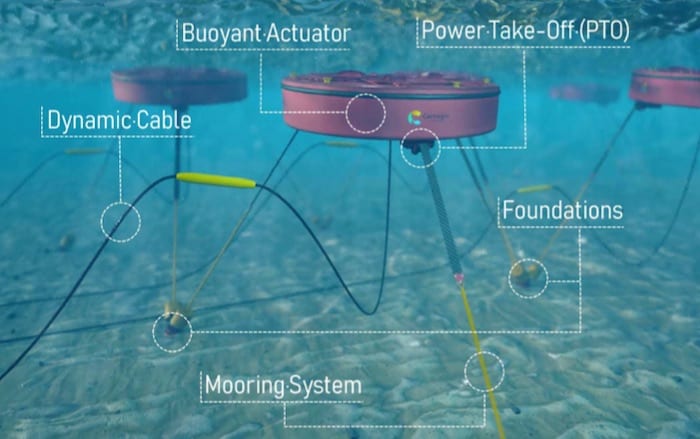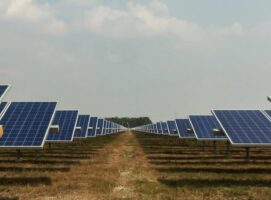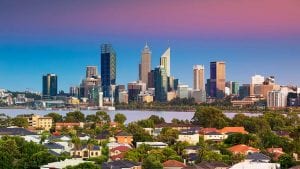Australian wave power technology company Carnegie Clean Energy is promising to deliver reliable renewable energy for offshore facilities, starting with the moored vessels used in the aquaculture sector.
Carnegie, which is best known for its large-scale CETO wave energy generators, said on Wednesday that it had received funding to install and operate a scaled demonstrator of the MoorPower technology, offshore from its headquarters in North Fremantle, Western Australia.
The $3.4 million project is being delivered in collaboration with a consortium of partners including two of Australia’s largest aquaculture companies, Huon Aquaculture and Tassal Group, with $1.35 million in funding from the Tasmania-based Blue Economy Cooperative Research Centre.
Carnegie says the MoorPower solution is a “spin-off” from the company’s proprietary core CETO wave energy technology, which features a submerged buoy that sits a few metres below the surface of the ocean, moving with the waves.
Like the CETO system, MoorPower will use a Power Take-Off (PTO) system that converts the orbital motion of the waves into clean electricity. But rather than being a stand-alone buoy system (pictured below), the scaled down technology will be designed to be integrated with moored offshore vessels.
In a statement this week, Carnegie said the new product launch was consistent with the company’s recent shift in focus to the development and commercialisation of proprietary technologies to efficiently and cost-effectively convert wave energy into electrical energy.
The company, which started its life as Carnegie Wave Power, went into voluntary administration in early 2019 after a series of blowouts and losses in former subsidiary microgrid business Energy Made Clean and the last-minute termination of a $16 million project contract.
Just before being reinstated to the ASX in October of that same year, Carnegie chairman Terry Stinson said the business had experienced “a very significant cultural reset” during its decline into administration.
“Reflecting on the past two years and the process of coming back from the brink has served to teach us painful but important lessons that are not soon forgotten,” Stinson said.
“The board members and key staff have used this learning to bring the business back from administration as we believe in Carnegie and in wave energy.
“We continue to believe that our CETO technology, as part of the emerging wave energy industry, can be a major contributor to the reduction in harmful emissions and contribute to a cleaner world for generations to come.”
To this end, Carnegie hopes MoorPower can be used to decarbonise the energy needs of offshore operations, particularly in aquaculture, whose operations such as feeding barges are moving further offshore, removing their access to shore-based power.
For now, this means they rely on diesel generators, which come with with high costs and carbon emissions, as well as other environmental risks such as fuel spillage.
But MoorPower can be deployed for any type of moored vessel and is not limited to fish farming – and Carnegie’s vision for the technology is that it will be an integrated solution with other offshore renewable energy systems including hydrogen and batteries.
“The elegance of the MoorPower aquaculture application for Carnegie is that these barges constantly move with the waves already and we have the electricity customer and an existing prime mover (the infrastructure being moved by the waves) in one pre-existing package,” said Carnegie’s CEO, Jonathan Fiévez.
“We are essentially optimising our CETO power take-off and controller to suit the application and provide a competitive offering.
“The technology also expands our market reach, while complementing the technical advancements being made on our CETO technology.
“Wave energy has the benefits of consistency and predictability, and in some places, wave may be the only renewable energy that is practical,” Fiévez said.
Academic and industry partners for the demonstration project include DNV GL Australia, Advanced Composite Structures Australia, University of Tasmania, Climate KIC/Australian Ocean Energy Group, AMC Search and University of Queensland.
As well as the funding from the Blue Economy CRC, the project will be financed by $265,000 from Carnegie and $1.8 million of in-kind support from all the project partners.
“We look forward to the opportunities the MoorPower technology presents to the aquaculture sector and the expansion into high energy offshore sites utilising clean and reliable energy solutions,” said Dr John Whittington, CEO Blue Economy CRC.
“The project allows the opportunity for collaboration between experts in the field led by Carnegie Clean Energy together with project partners across the country.”











